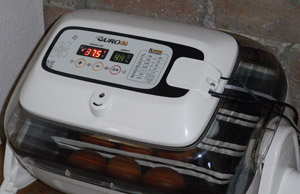How to Hatch Eggs
Before you start
Before you incubate and hatch chicks, you should remember that you will end up with a ratio of half male and half female chicks. Unless you are hatching an autosexing breed (where markings or colour of the chicks are different colours) or have crossed two birds that give a sex-linked chick (again, different down colour or markings) then you will need to think ahead to when the young growers can be sexed around 8 weeks of age and consider what you will do with the excess of male birds. Sadly, they are very hard to re-home, everyone has the same problem: too many boys.Choice of incubator
 Pin It
Pin It
The R-Com Suro is a forced air incubator that controls both temperature and humidity.
Incubating Chickens Eggs
Chickens eggs have a 21 day incubation period (isn’t that amazing? Egg to chick in just 3 weeks!) and require a constant temperature of 37.5°C. Eggs will start to produce their own heat in the latter stages of development but the incubator thermostat takes care of this, keeping the temperature the same throughout the incubation period. Humidity should ideally be between 45 and 50%. Eggs need turning regularly by 180 degrees and you will need to do this yourself if the incubator doesn’t have an automatic turning mechanism. Expect 50% to 75% of your eggs to hatch, not all eggs will be fertile.Hatching Eggs
Eggs need to be fertile so a cockerel needs to be running with the hens for a few weeks before eggs are taken for hatching. If you have a cockerel, you can collect your own hatching eggs from your chickens. Try to pick good looking ‘egg shaped’ eggs, this will help the chicks form and hatch correctly as mother nature intended. Keep nest boxes clean and don’t set any soiled eggs. If you don’t have a cockerel or would like a different breed, there are many hatching eggs for sale online on sites such as eBay but keep in mind that just about anyone and everyone sells eggs so birds vary in quality between sellers. Hatching eggs travelling through the postal system can be damaged internally and either not develop or die before they hatch. These are often called dead in shell.Incubation tips:
- Before you put your eggs into any incubator, make sure it has been sterilised with an incubation disinfectant (or as a minimum warm soap and water if you don’t have this). This will kill bacteria that multiply rapidly in the warm temperature of the incubator.
- Plug in your incubator and make sure the temperature is steady at 37.5°C. Always leave it to run overnight to settle before putting eggs in.
- Keep water reservoirs topped up so that adequate humidity can be maintained at all times.
- Candle eggs before putting them into the incubator. Cracked or damaged eggs do not hatch and should be removed after candling (see below for more information on candling).
Candling Eggs
 Pin It
Pin It
Candling an egg in the dark using a special candling torch. Blood vessels and the embryo can be clearly seen after a week.
The Air Sack
An Air Sack is formed at the broad end of the egg shortly after an egg is laid. There is a membrane between this and where the chick is developing. When candling periodically through the incubation period, this is the best method of judging normal development and you will see this increase in size up until the point that the chick breaks through into this air sack.The Hatch
- A chick will usually ‘pip’ the shell a few hours after breaking into the air sack so she can breathe but a full hatch can take 12 or more hours from this point so be patient.
- If humidity has been set too high during the incubation period, the chick may pip the shell underneath the shell and drown in the fluids before he can get his beak out of the shell.
- If the humidity has been too low, the air sack will be too large and the chick will be under-developed and may become stuck to the shell, too weak to break free.
And finally…
- Do not remove hatched chicks until they are fully dried out. Chicks do not need to eat for 24 hours. This is why they can be shipped around commercially as ‘day old chicks’.
Source: http://keeping-chickens.me.uk/chickens/how-to-hatch-eggs

